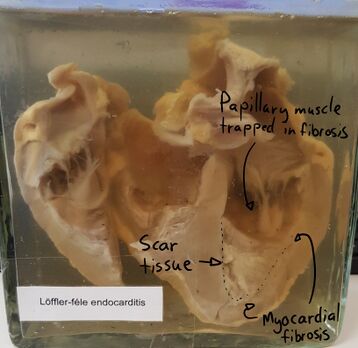46. Löffler’s endocarditis
Organ: Heart
Description:
Inside the left ventricle there is a huge mass of scar tissue. The mass is so large it actually traps the papillary muscle. In the lateral wall of the ventricle can we see greyish discoloration of the myocardium, compared to the rest of the myocardium, which is brownish.
Diagnosis: Löffler endocarditis
Causes:
- Hypereosinophilic conditions
Theory:
Löffler endocarditis is a condition that causes endocardial fibrosis. The fibrosis of the endocardium creates a thrombogenic surface, so Löffler’s endocarditis often presents with a mural thrombus. However, in the late stage of the disease will also the myocardium be fibrotic. At this point is the condition called endomyocardial fibrosis. In this late stage will mural thrombi also be organized into scar tissue, as seen in this case. The scar tissue is so large that it fills the left ventricle and traps the papillary muscle. Myocardial fibrosis is also visible on the lateral wall. As with any disease that causes fibrosis of the myocardium is it a restrictive heart disease, but it’s not a type of restrictive cardiomyopathy.
This preparation should’ve been called Löffler’s endomyocarditis, late-stage Löffler’s endocarditis or endomyocardial fibrosis. We should know the different causes (differential diagnosis) of endomyocardial fibrosis:
- Amyloidosis
- Hypereosinophilia (Löffler endocarditis)
- Radiation (cancer treatment)
- Sarcoidosis (rare)

